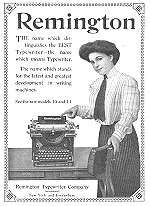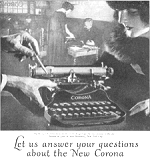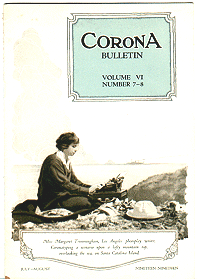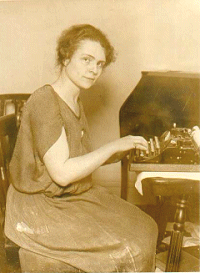|
Click any image


|
 The changes in working habits sparked off by the introduction of portable
typewriters came at the same time as dramatic social changes in the position of
women. In 1909, when the advertisement shown on the left was published, Remington
and Underwood dominated the typewriter market with their standard desk models
and most typewriters were heavy machines costing hundreds of dollars. In this
ad, the attractive girl stands demurely by a heavy, expensive desk model, on
which she will type out the letters of the man for whom she works in an office,
somewhere in the commercial district. Compare the social values of this ad
with those of the advertisement below published in 1923, little more than a
decade later. Not only has the typewriter become small and light enough to
hold in one hand but the attractive model no longer portrays the typist but the
customer. She is also no longer the demure, hopeful young thing, but has a touch
of the femme fatale. And now she is the one asking her own questions, not
enduring life
in a stuffy male-dominated office. These changes in advertising reflected the
social changes that had taken place in a remarkably short time in the real world
where changes were, if anything, even more dramatic. In 1885 there was an outcry
when the YWCA in New York offered typing courses to young women. Such a course
of action, it was argued, would give young women ideas and could lead to them
leaving home and leading selfish, hedonistic lives -- perhaps even immoral
behaviour. As early as 1919, the Corona Bulletin, above right, was showing the
New Woman, screenwriter Margaret Trimmingham, writing on a cliff at Catalina. By the end of the twenties, the press was printing photos such as
that below of Miss Katherine MacGregor, typing on her Corona 4. The worst
fears of the blue stockings who opposed typing lessons in 1885 were realised;
young women were not only leading their own lives -- they were writing their
memoirs about it on their own portable typewriters. An important part of these
changes came about because the typewriter enabled women to acquire the skill to
earn a living and lead independent lives. The portable machine took this
process a stage further because women -- and men -- were able to own their own
machine and run their own small businesses. The changes in working habits sparked off by the introduction of portable
typewriters came at the same time as dramatic social changes in the position of
women. In 1909, when the advertisement shown on the left was published, Remington
and Underwood dominated the typewriter market with their standard desk models
and most typewriters were heavy machines costing hundreds of dollars. In this
ad, the attractive girl stands demurely by a heavy, expensive desk model, on
which she will type out the letters of the man for whom she works in an office,
somewhere in the commercial district. Compare the social values of this ad
with those of the advertisement below published in 1923, little more than a
decade later. Not only has the typewriter become small and light enough to
hold in one hand but the attractive model no longer portrays the typist but the
customer. She is also no longer the demure, hopeful young thing, but has a touch
of the femme fatale. And now she is the one asking her own questions, not
enduring life
in a stuffy male-dominated office. These changes in advertising reflected the
social changes that had taken place in a remarkably short time in the real world
where changes were, if anything, even more dramatic. In 1885 there was an outcry
when the YWCA in New York offered typing courses to young women. Such a course
of action, it was argued, would give young women ideas and could lead to them
leaving home and leading selfish, hedonistic lives -- perhaps even immoral
behaviour. As early as 1919, the Corona Bulletin, above right, was showing the
New Woman, screenwriter Margaret Trimmingham, writing on a cliff at Catalina. By the end of the twenties, the press was printing photos such as
that below of Miss Katherine MacGregor, typing on her Corona 4. The worst
fears of the blue stockings who opposed typing lessons in 1885 were realised;
young women were not only leading their own lives -- they were writing their
memoirs about it on their own portable typewriters. An important part of these
changes came about because the typewriter enabled women to acquire the skill to
earn a living and lead independent lives. The portable machine took this
process a stage further because women -- and men -- were able to own their own
machine and run their own small businesses.
 Miss Katherine MacGregor, the young woman explorer who was the first white woman
to cross the Andes over the Lima-Para trail, who leaves New York today for South
America, in search of a "lost world". She will go to the interior of
Colombia, by canoe, taking the trail to the interior, with movie cameras,
recording the life of the head-hunting and savage tribes. She is a Wisconsin
girl, former student of the Columbia School of Journalist. She will hunt big
game on the jungles, and take data for a book which she will publish on her
return.
Miss Katherine MacGregor, the young woman explorer who was the first white woman
to cross the Andes over the Lima-Para trail, who leaves New York today for South
America, in search of a "lost world". She will go to the interior of
Colombia, by canoe, taking the trail to the interior, with movie cameras,
recording the life of the head-hunting and savage tribes. She is a Wisconsin
girl, former student of the Columbia School of Journalist. She will hunt big
game on the jungles, and take data for a book which she will publish on her
return.
|